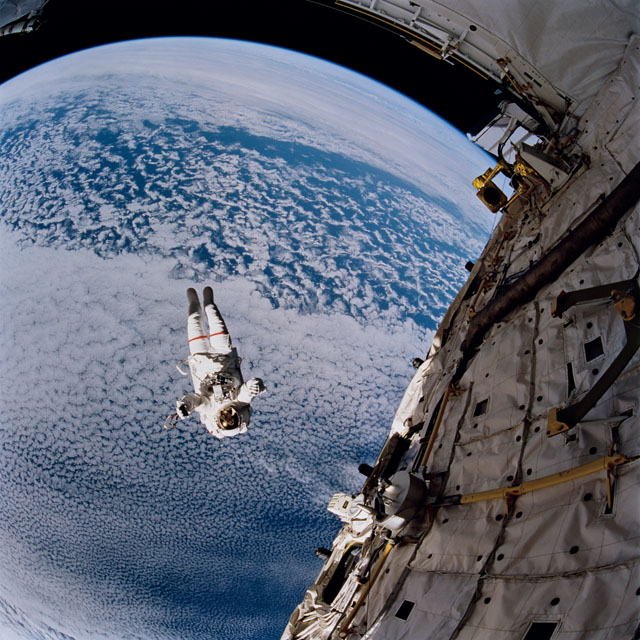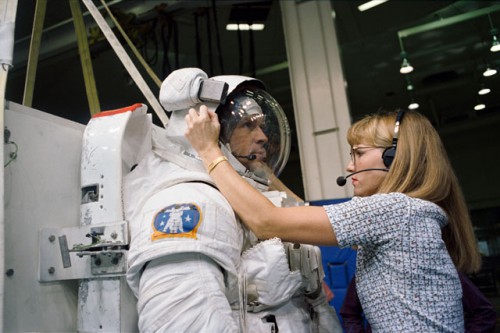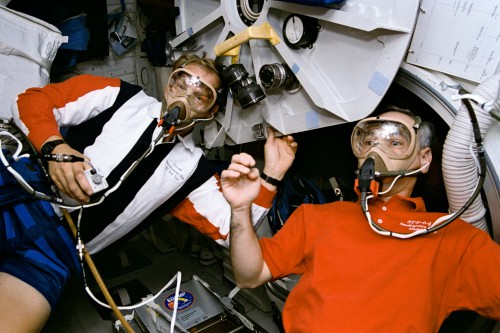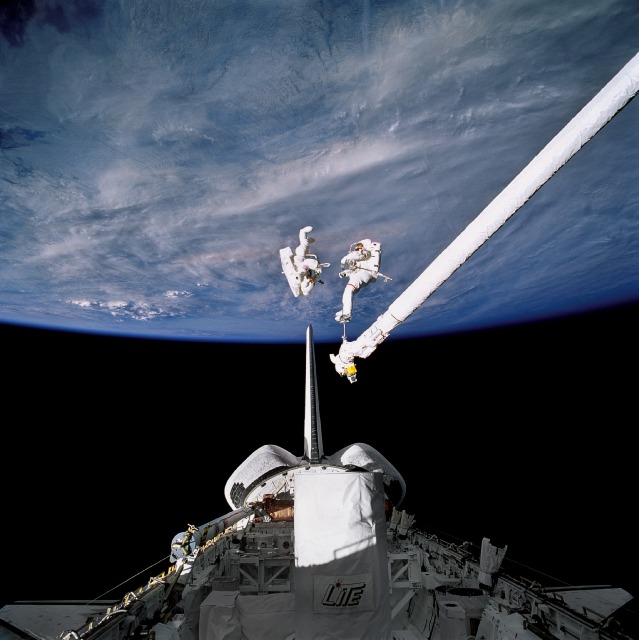
One hundred and twenty-three times before 16 September 1994, astronauts and cosmonauts had clambered outside their space ships and maneuvered themselves around in the harsh and unforgiving vacuum of space. They had used handholds, they had used tethers, and they had used specialized maneuvering units to prevent them from losing contact with their vehicles and floating away into the void. When STS-64 astronauts Mark Lee and Carl Meade ventured outside Shuttle Discovery’s airlock on the morning of that fall day in 1994—20 years ago, next week—they wore something quite different and entirely new on their space suits. Known as the “Simplified Aid for EVA Rescue” (SAFER), it cost $7 million to develop and its descendents are today utilized aboard the International Space Station (ISS).
Unlike the Manned Maneuvering Unit (MMU), first trialed by Bruce McCandless during Mission 41B in February 1984 and later employed operationally to service NASA’s Solar Max observatory in April 1984 and retrieve the stranded Palapa-B2 and Westar-6 communications satellites in November 1984, SAFER was never meant for repairing spacecraft. Rather, it provided a design solution for the shuttle program’s requirement to offer a method of “self-rescue” in the event that a spacewalker became physically disconnected from his or her tether during the course of an EVA.
True to its acronym, SAFER’s design centered on the fact that in the event of a tether failure, it would be hugely difficult to undock the shuttle from the space station, rendezvous and retrieve the lost crew member, and redock in a safe manner. SAFER quite literally provided a safer means of going about EVA and, on STS-64, supported the United States’ first untethered spacewalk in almost 10 years. Developed by the Automation and Robotics Division at NASA’s Johnson Space Center (JSC) in Houston, Texas, it weighed 83.1 pounds (37.7 kg), less than a third as much as the MMU, carried 24 fixed-position compressed nitrogen thrusters, and was attached to six “hard-points” at the base of the space suit’s life-sustaining backpack. Powered by a 28-volt battery pack, SAFER included an automatic attitude-hold mechanism and six degrees of freedom. Unlike the MMU, it had no bulky arms for hand controllers, instead being equipped with thruster “towers,” extending up the sides of the backpack, and on STS-64 Lee and Meade operated it from controls hard-secured to their suit torsos. (In the current ISS configuration, SAFER’s controller is embedded within one of the thruster towers and is swung out by the simple pulling of a lanyard.)

When the STS-64 crew was announced in November 1993, it originally comprised five veteran astronauts: Dick Richards in command, Blaine Hammond as pilot, and mission specialists Susan Helms, Carl Meade, and Mark Lee. Unusually, in February 1994, a sixth crew member—U.S. Navy physician Jerry Linenger—joined the crew as a mission specialist. “This assignment,” read the space agency’s press release, “was made to more efficiently distribute the crew workload for this complex flight.” However, there existed a secondary reason for the arrival of Linenger, whose experience was expected to be “of great value in ongoing human physiology investigations.” Specifically, those “investigations” were the need for medically-qualified astronauts to fly long-duration (and medically focused) expeditions to the Mir space station … and, coupled with Russia’s insistence that all of the NASA flyers must have prior flight experience, Linenger was slotted into the earliest available shuttle mission, which happened to be STS-64.
Selected as an astronaut candidate in March 1992, with STS-64 he became the first of his class—nicknamed “The Hogs”—to fly into space and established a shuttle-era record of less than 30 months between admission into the NASA astronaut corps and first liftoff. One of Linenger’s key responsibilities was to provide “intravehicular” support for Lee and Meade during their EVA. Although he would go on to make an EVA, later in his astronaut career, for Linenger the sight of his crewmates floating against the serene backdrop of Earth and the ethereal of blackness of space was unforgettable. “The one thing I’ll always picture from STS-64 is watching Carl Meade and Mark Lee out there testing the new jetpacks,” he told a Smithsonian interviewer, “spinning on the end of the arm, totally free of the shuttle and the Earth below them. It’s one of those pictures that’s pretty much imprinted in my brain, even though I wasn’t doing the spacewalk.”
During more than nine months of training, Lee and Meade spent considerable time working with the SAFER engineers and performed evaluations on the ground. Their four crewmates supported the EVA from Discovery’s aft flight deck, intricately guiding the orbiter itself, controlling the Canadian-built Remote Manipulator System (RMS) mechanical arm and overseeing the timeline for their 6.5 hours outside. The spacewalkers were to venture no more than 27 feet (8.2 meters) from the shuttle, operating within a “box” of space at the forward end of the payload bay, and their tasks encompassed familiarization with SAFER and a programmed series of nitrogen-jet tests to gather engineering data, together with translating and tumbling tests and demonstrations of precision maneuvering.

Emerging from Discovery’s airlock, the spacewalkers activated their helmet lights to provide greater illumination during orbital darkness and began a standard translation exercise to get their bearings. Neither man had performed an EVA before, although Mark Lee had worked extensively on spacewalking techniques since the start of his astronaut career. (In fact, he had worked with fellow astronaut Jerry Ross in April 1985 during plans to develop a “contingency” EVA for Mission 51D.) Now, on STS-64, Lee was so anxious to begin testing SAFER that he completed barely half of his translation, before getting ready to fly the new device. “The first thing we did was a little familiarization maneuver, then we did a gaseous nitrogen calibration, to make sure that the fuel we were using in orbit was very comparable to what we did in training,” he recalled at the post-mission press conference. “When we got back after the calibration, we found out that the consumption was exactly as we planned, so I got to do a few optional maneuvers. I went in front of the windows to do some rolls and yaws to try to see how much ‘cross-coupling’ there was when you weren’t using the attitude-hold feature of the SAFER.” As each spacewalker performed his tests with the device, the other was involved in tool setups and evaluations for the next task.
With Helms operating the RMS, each man took turns standing in a mobile foot restraint on the end effector and “tumbling” his colleague. The tumbled astronaut then activated SAFER’s automatic attitude-hold system, stabilized himself, and maneuvered toward the arm, which Helms pulled away to simulate a separate rate of about 0.2 feet (0.06 meters) per second. The astronauts quickly determined that the device used less nitrogen than predicted, and on one occasion Meade “rolled” Lee at about two revolutions per minute, somewhat quicker than planned, but his SAFER successfully stabilized him without incident. They evaluated their capability to replenish gaseous nitrogen from a recharging unit in the payload bay and flew the unit precisely along the length of the RMS.

Overall, SAFER’s first trial was a huge success, with the only problem of note arising from glitches with the battery-powered Electronic Cuff Checklist, which was capable of storing 500 pages of information, including graphics and photographs on its small screen. On a number of occasions, it did not respond to commands when the upper-middle sextant was depressed and efforts to update its contents resulted in an error message being displayed. However, it remained usable and Lee and Meade spoke glowingly of its performance later. Unlike previous printed notebooks attached to the space suit cuff, which held 25-50 pages of notes, usually detailing critical functions, such as emergency operations, the two-megabyte Electronic Cuff Checklist, and its touch screen enabled its wear to scroll through much more information in support of more complex EVAs, such as Hubble Space Telescope servicing missions or space station construction tasks.
It could also be updated electronically from one of the orbiter’s laptop computers. For this assessment, Lee and Meade wore an Electronic Cuff Checklist on the left arm of their suits and a standard, printed checklist on the right arm. The EVA lasted six hours and 51 minutes and formed the capstone of a multi-faceted mission which showcased virtually all of the shuttle’s capabilities: from spacewalking to scientific research and from satellite deployment to rendezvous, proximity operations, and payload retrieval.
The second part of this article will appear tomorrow.
Want to keep up-to-date with all things space? Be sure to “Like” AmericaSpace on Facebook and follow us on Twitter: @AmericaSpace



